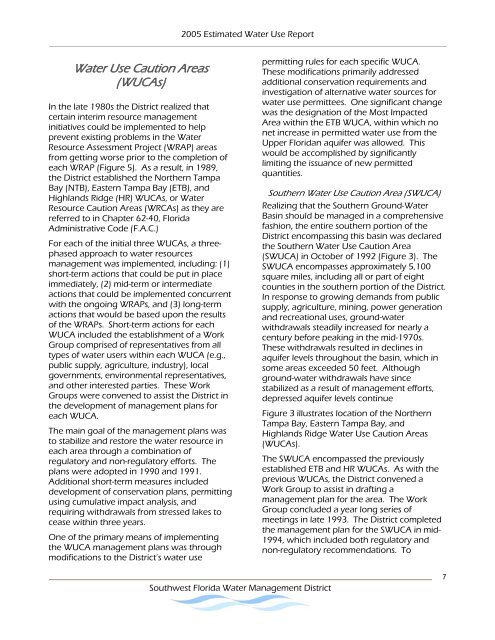Estimated Water Use Report - Southwest Florida Water ...
Estimated Water Use Report - Southwest Florida Water ...
Estimated Water Use Report - Southwest Florida Water ...
You also want an ePaper? Increase the reach of your titles
YUMPU automatically turns print PDFs into web optimized ePapers that Google loves.
2005 <strong>Estimated</strong> <strong>Water</strong> <strong>Use</strong> <strong>Report</strong><br />
<strong>Water</strong> <strong>Use</strong> Caution Areas<br />
(WUCAs)<br />
In the late 1980s the District realized that<br />
certain interim resource management<br />
initiatives could be implemented to help<br />
prevent existing problems in the <strong>Water</strong><br />
Resource Assessment Project (WRAP) areas<br />
from getting worse prior to the completion of<br />
each WRAP (Figure 5). As a result, in 1989,<br />
the District established the Northern Tampa<br />
Bay (NTB), Eastern Tampa Bay (ETB), and<br />
Highlands Ridge (HR) WUCAs, or <strong>Water</strong><br />
Resource Caution Areas (WRCAs) as they are<br />
referred to in Chapter 62-40, <strong>Florida</strong><br />
Administrative Code (F.A.C.)<br />
For each of the initial three WUCAs, a threephased<br />
approach to water resources<br />
management was implemented, including: (1)<br />
short-term actions that could be put in place<br />
immediately, (2) mid-term or intermediate<br />
actions that could be implemented concurrent<br />
with the ongoing WRAPs, and (3) long-term<br />
actions that would be based upon the results<br />
of the WRAPs. Short-term actions for each<br />
WUCA included the establishment of a Work<br />
Group comprised of representatives from all<br />
types of water users within each WUCA (e.g.,<br />
public supply, agriculture, industry), local<br />
governments, environmental representatives,<br />
and other interested parties. These Work<br />
Groups were convened to assist the District in<br />
the development of management plans for<br />
each WUCA.<br />
The main goal of the management plans was<br />
to stabilize and restore the water resource in<br />
each area through a combination of<br />
regulatory and non-regulatory efforts. The<br />
plans were adopted in 1990 and 1991.<br />
Additional short-term measures included<br />
development of conservation plans, permitting<br />
using cumulative impact analysis, and<br />
requiring withdrawals from stressed lakes to<br />
cease within three years.<br />
One of the primary means of implementing<br />
the WUCA management plans was through<br />
modifications to the District’s water use<br />
permitting rules for each specific WUCA.<br />
These modifications primarily addressed<br />
additional conservation requirements and<br />
investigation of alternative water sources for<br />
water use permittees. One significant change<br />
was the designation of the Most Impacted<br />
Area within the ETB WUCA, within which no<br />
net increase in permitted water use from the<br />
Upper <strong>Florida</strong>n aquifer was allowed. This<br />
would be accomplished by significantly<br />
limiting the issuance of new permitted<br />
quantities.<br />
Southern <strong>Water</strong> <strong>Use</strong> Caution Area (SWUCA)<br />
Realizing that the Southern Ground-<strong>Water</strong><br />
Basin should be managed in a comprehensive<br />
fashion, the entire southern portion of the<br />
District encompassing this basin was declared<br />
the Southern <strong>Water</strong> <strong>Use</strong> Caution Area<br />
(SWUCA) in October of 1992 (Figure 3). The<br />
SWUCA encompasses approximately 5,100<br />
square miles, including all or part of eight<br />
counties in the southern portion of the District.<br />
In response to growing demands from public<br />
supply, agriculture, mining, power generation<br />
and recreational uses, ground-water<br />
withdrawals steadily increased for nearly a<br />
century before peaking in the mid-1970s.<br />
These withdrawals resulted in declines in<br />
aquifer levels throughout the basin, which in<br />
some areas exceeded 50 feet. Although<br />
ground-water withdrawals have since<br />
stabilized as a result of management efforts,<br />
depressed aquifer levels continue<br />
Figure 3 illustrates location of the Northern<br />
Tampa Bay, Eastern Tampa Bay, and<br />
Highlands Ridge <strong>Water</strong> <strong>Use</strong> Caution Areas<br />
(WUCAs).<br />
The SWUCA encompassed the previously<br />
established ETB and HR WUCAs. As with the<br />
previous WUCAs, the District convened a<br />
Work Group to assist in drafting a<br />
management plan for the area. The Work<br />
Group concluded a year long series of<br />
meetings in late 1993. The District completed<br />
the management plan for the SWUCA in mid-<br />
1994, which included both regulatory and<br />
non-regulatory recommendations. To<br />
<strong>Southwest</strong> <strong>Florida</strong> <strong>Water</strong> Management District<br />
7
















